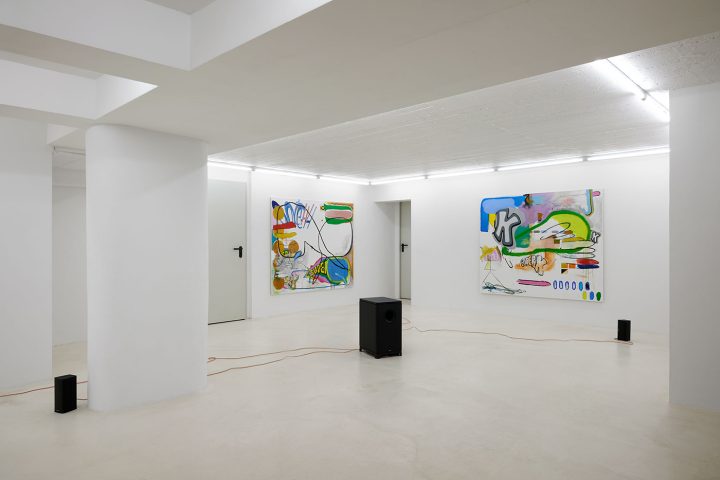Luke Calzonetti
Super K Sha-La-La
April – May 2023
Exhibition Views















Super K was a short-lived record label in the late 1960s/early ‘70s that released albums and singles by Freddie & the Dreamers, Captain Groovy And His Bubblegum Army, and The Kasenetz-Katz Orchestral Cirkus—groups many of us may not be familiar with. Long ago, far away. Except for Freddie & the Dreamers, they weren’t really groups at all, but more of a studio production, parts assigned and performed under the direction of two producers, Jerry Kasenetz and Jeff Katz. They scored hits with the Music Explosion, the Ohio Express, and the 1910 Fruitgum Company, released on Buddha, a bigger company at the time. (Some of Super K’s records were issued in Europe by the Berlin-based Hansa label.) Certain aficionados of obscure music and not-so guilty pleasures, however, such as the artist and musician Luke Calzonetti, are well aware of Super K, particularly because of its classic ‘70s logo. Hand-drawn in bulging, rounded letters, emerging from a goofy star, ending with a giant K, as if meant for a cereal box, the logo appears prominently in the artist’s new paintings. If these works find visual resonance with the sugar-coated pop of that music—a genre, bubblegum, already on the way out as the vinyl was being pressed, replaced by the era’s psychedelic and heavier rock, funk and soul—it would be burnt sugar at the edges of a heady discordance and erasure. To play an original copy a Super K record now, more than fifty years later, used and abused, we would likely hear what can be seen in Calzonetti’s paintings: surface noise, skips, scuffs, clicks, pops and the smudged residue of the fingers that held it, their oil seeped into its grooves, pretty pastel tones brightening the grime.
With their 45s, Kasenetz and Katz would occasionally put the same song on the B-side of the record, but run backwards, to make sure that radio station DJs played the A-side. But some of them went ahead and played it anyway, the music and vocals pulled and distorted as if in a funhouse mirror. This relates to how Calzonetti has taken the Super K logo as a point of departure for his painterly moves, which are intuitive, gestural, improvisatory, and, like the artist himself, fueled by an irreverent intelligence. To quote the lyrics to a top-ten AM radio hit from 1968 by The American Breed: “Bend me, shape me / Any way you want me.” This is how he treats the logo, as a purely malleable form. Although never reversed, we can’t help but wonder: Is there such a thing as painting backwards? In these works, what might appear at odds with itself—mark-making and erasure, candy colors and dirty atmospherics, pop-tones and expressionist scumble—is all key to his compositional style. As in post-punk and no wave, one guiding principle was simply: “Do the wrong thing.” This is both freeing and done consciously. With these paintings, Calzonetti is exploring “ideas about personal artistic style,” and how it can be either liberating or oppressive.
The fact that there are four Super K paintings, suggesting reciprocal movements in a larger composition, allows us to see intention behind them: to paint without needing to represent anything but the act itself, as well as the artist’s sensibility. He identifies it as: “non-intellectual, hysteric, quick, joyful.” Each painting reveals something in the others, something that has been alternately submerged and brought to the surface, amplified or muted. Volume will rise and fall, at times within the same measure. For all the apparent clamor, his speech bubbles are empty, yet these paintings possess acoustic properties.
The exhibition also includes a series of gouaches that appear to be woodcuts, which Calzonetti associates with those created in the 1890s by the symbolist author Alfred Jarry, who the artist is familiar with from literature and by way of the group Pere Ubu, worthy heirs to the author’s anarchic, dark spirit. The gouaches, monochromatic, ghostly impressions, relate to the non-narrative abandon of the Super K paintings, and to Jarry’s playful experimentation with typography and a delight in absurdity. This was someone who referred to the wind as “that which blows.” The hand, for Calzonetti, may be thought of as “that which draws, writes, speaks,” all of which prompt self-reflection. He refers to these works on paper as “letters to myself,” diaristic entries, dated and undated, that incorporate collaged images from cards used in speech therapy. Each page in this “diary” served as a memory device and, in parallel to how we tend to remember things, there is a disjointed quality to the image and text, a visualization of how thoughts swirl and collide, come forward and recede. With them, notes both to himself and to friends who have passed away, still alive in his mind, Calzonetti rescues experience that might otherwise have been lost. Every image, we may well conclude, is an after-image.
Writing is a form of recall. Is this true for painting as well?
Bob Nickas, New York, March 2023
